
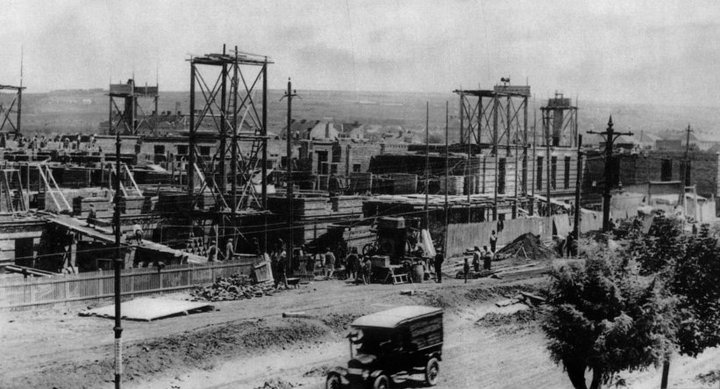
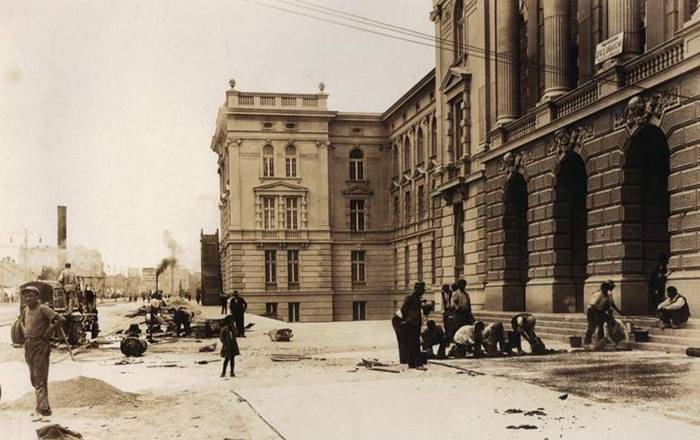
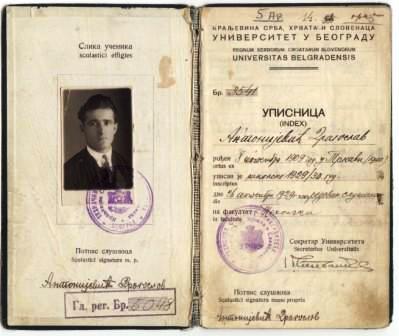
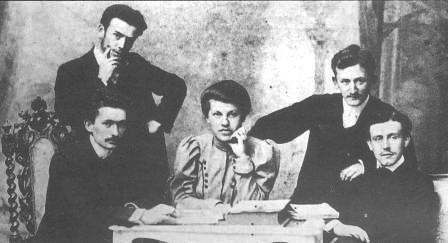
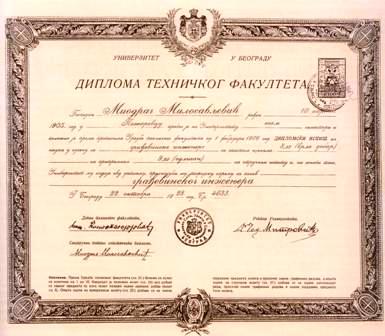
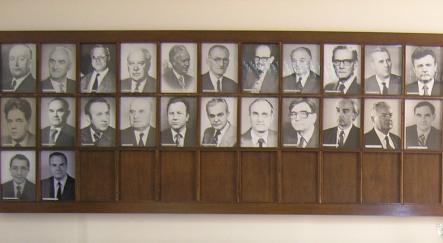
The University of Belgrade Faculty of Civil Engineering is the oldest and leading educational and scientific institution in the field of civil engineering and geodesy in Serbia and in territory of former Yugoslavia.
The beginning of teaching and education in the field of civil engineering and geodesy at university level dates back to 19th June 1846. when the School of Engineering was formed at Lyceum in Belgrade. The founder and creator of The Engineering school was Atanasije Nikolic (1803-1882), an engineer and the first rector of Lyceum and later, the initiator of Serbian Academy. The following subjects were lectured at the School: Practical Geography, Mechanics, Architecture, Drawing and German. The studies lasted for three years, and in the Decree on school establishing it was stated:”Subjects above will be lectured as theoretical in this school during winter and, in summer, the students of this school will be engaged, alongside engineers, in measuring and construction of buildings and roads in order to practice, supervise and execute various structures according to plans.”
The New Act on Lyceum organization, enacted in 1853, enabled progress in the education of engineer personnel in Serbia. Lyceum was ''divided into three science departments: legal sciences, natural and technical sciences and general sciences department.'' The studies lasted for three years, but could not be compared to the studies of technical sciences in Europe at that time. The subjects lectured at Lyceum were supposed to enable future civil officers to gain basic knowledge of general techniques, and the most talented students had the opportunity to continue their studies at one of European colleges of technical sciences. At that time, many eminent scientists worked at Lyceum: Josif Pančić, Đura Daničić, Janko Šafarik, Emilijan Joksimovic and others.
The establishment of Serbian Ministry of Construction in 1862, with its task to take care of ''roads and bridges construction and maintenance, streets and river regulation, building up monuments and public buildings'', set the basis of construction legislation in Serbia. The Law on Establishing the Higher School (1863-1905) was enacted in the following year. The School comprised three faculties: Faculty of Philosophy, Technical Faculty and Faculty of Law. The Law stipulated that the studies last four years. At the Technical Faculty the following subjects were lectured: Mathematics, Physics, Descriptive and Practical Geometry, Science Construction on Moisture Free Basis, on Water Basis and others. New subjects were introduced by subsequent Law from 1873: Technical Drawing, Descriptive Geometry with Geometric Drawing, Practical Geometry with Topographic Drawing, Mechanics and Science of Machines, Science of Construction on Moisture Free Basis, Science of Construction on Water Basis and Road Construction, Chemical Technology, Physics, Mineralogy with Geology, Chemistry, Higher Mathematics, Hygiene and French.
The organization of Higher School Technical Faculty, with its curricula and syllabi, changed considerably at the end of 19th century. By the Law from 1897, lectures for the three departments were divided: Construction and Engineering Department, Department of Architecture and Machine-technical Department. A total of 46 subjects were lectured, all of which were divided into preliminary and vocational ones. Semi-annual examinations were taken in the presence of the examination commission chaired by the Dean.
The Higher School with its departments merged to form a single University in 1905. The first rector of the University was Sima Lozanić, a prominent teacher and scientist of the time. His words from the opening ceremony of University remain recorded:
''Our former belief, that Serbia will not be united by a book, but by arms, was fatal to our national thought. I believe the opposite, that education will be a major factor in the solution of this important issue, and that it would have already been resolved if we had nurtured education better. I believe, therefore, that education is the force that influences all areas. If our education had been more advanced, everything in life of our nation could have been better and more successful. ''
With the establishment of the University and the curriculum reform a number of students increased. In the academic year 1906/1907. 149 students enrolled the Technical Faculty, 99 of them in the Department of Civil Engineering and others enrolled in the Departments of Architecture and Mechanical Engineering.
During the period from 1918 to 1948, the number of subjects and requirements the students had to meet increased. A growing number of students lead to the lack of classroom space. Next to the old Captain Misa building, a new building was built in the early twenties, primarily intended for the Technical Faculty, but in 1931 another new building was built on the former ''racecourse'' in Kralja Aleksandra Boulevard, where the Faculty of Civil Engineering is located today, together with the Faculty of Architecture and the Faculty of Electrical Engineering.
According to the Decree from 1935, Faculty of Technology’s Construction Department subdivided into four groups: Geodesy, Traffic Engineering, Static-constructive and Hydro-technique. The Profile of the studies equalled that at foreign universities, methodology being more like in other countries, thus resulting in the increased theoretical and practical knowledge. A large number of renowned experts and specialists had been engaged in the education of skillful civil engineers, who later inherited their professors or became known constructors in the country and abroad. 1082 construction and geodesy engineers graduated between the two wars.
During both World Wars, the University was closed, the buildings and equipment were heavily damaged, archives destroyed, and many professors, students and civil engineers - former students of our school, lost their lives for freedom of the country on various battlefields.
The Faculty resumed working after World War II. By the Government Regulation of PR Serbia from 1948, the Technical Faculty was exempt from the University of Belgrade and was turned into Technical Higher School. Former Construction Department became an independent Faculty of Civil Engineering, with Geodesy Department within it. The organization of teaching programs, departments division and study mode were adjusted to the needs of the profession. The studies usually lasted for nine semesters, with the tenth semester intended for preparation of the thesis. By Regulation of Executive Council of PR Serbia from 1954, By the Regulation of the Executive Council of PR Serbia from 1954, The Higher Technical School, together with The Higher Medical school, was integrated into the University of Belgrade. At the same time, all the Faculties that previously belonged to The Higher Technical School, including the Faculty of Civil Engineering, were integrated as well. Postgraduate studies were introduced in 1963. significantly improving the development of scientific research at the University.
The Statute from 1966 reintroduced the system of continual education and the studies were extended to five years. New curriculum implied common subjects for all students in the first four semesters at the Construction Department, while at the Department of Geodesy the classes were held by a separate plan starting from the beginning of the school year. According to the Plan from 1966/67, seven generations of students enrolled in the Faculty, the last one in 1972/73.
By adopting the Law on higher education in 1972, Faculties got limited number of hours for lectures and exercises, 30 lectures a week. New curriculum introduced Marxism, the social and economic system of Yugoslavia, while leaving out Chemistry, and Basics of Programming were introduced in senior academic years. The Faculty purchased an electronic computer and established the Computer center in 1971. The duration of classes and the department division did not change. The novelty was that each semester had been divided into two half semesters, thus increasing a number of exams. In last half semesters of even semesters, teaching in the Department of Geodesy lasted for three weeks, while training classes were reserved for the fourth week.
Due to the demands for more classes of the subject in the area of Marxism, changes to 140 hours were made in 1976/77. Some subjects were left out in order to allow the introduction of Marxist education.
The new curriculum, whose implementation began in 1977/78, retained the organizational structure of the Faculty with three Construction and one Geodesy Department. Independent Geodesy Department introduced five courses in the ninth semester. 10 generations of students enrolled the Faculty according to this course of study.
In 1987, together with the preparation of the new curriculum and syllabus, the standardization of the scientific fields and disciplines at the University was in progress. Geodesy science, at the list of technical sciences, was assigned a special autonomy. According to a new classification, new scientific areas, that include scientific disciplines, were introduced. Every scientific field comprised three to five science disciplines. PhD thesis were related to the scientific areas, MSc and specialist thesis to scientific areas within relevant scientific fields, and graduate works were related to disciplines within scientific fields.
The University Law, from 1990, introduced new changes in the curricula of the Faculty. By the new Faculty Statute, in 1990, departments were established for one or more related subjects.
In academic 1991/92 year, the Faculty of Civil Engineering enrolls students who started their studies in Croatia (120) and Bosnia and Herzegovina (127). The number of these students decreased in the following 1992/93, enrolling 18 students from Croatia and 57 students from Bosnia and Herzegovina. Academic 1993/94 year enrolled 31 students from Croatia and 29 students from Bosnia and Herzegovina.
The conditions for the development of a new curriculum and syllabus were created by the new University Act from 1992 and by its modifications from in 1993. These came into effect in 1993/94.
The Faculty Statute, from 1993, defined departments as the representatives of scientific and educational work, and institutes were defined as operating units.
The reform, from 1994, made minor changes to the curriculum and brought important innovation of syllabus. The first year of studies in all five departments of the Faculty was common. Curricula adoption fell under the competence of the Academic Council of Faculty and was being approved by the Academic Council of the University.
The Act from 1998. introduced a more direct influence of the Government on higher education, causing major problems in the functioning of Serbian universities. The Act from 2002. was adopted primarily to decline some decisions of the previous Law, and it largely relied on statutory provisions of the Law enacted ten years earlier, i.e. 1992.
The period from 2005. to 2008. was characterized by the most important reforms of higher education, in accordance to Bologna Process, implemented by the Act on Higher Education, in 2005. After very serious education reform in the spirit of Bologna, the Faculty of Civil Engineering began enrolling students according to the new curricula from the academic year 2005/06.
The period after 2008 has been an accreditation period for study programs, in accordance with the Act on Higher Education and the adopted standards. The Faculty of Civil Engineering has accredited 7 study programs for 707 students.
Since the establishment of the Faculty of Civil Engineering as an independent institution of higher education, about 11,600 construction and geodesy engineers have graduated, and about 540 MSc and 285 PhD theses have been defended. During this period a large number of great names of Serbian construction lectured at the Faculty, while 16 regular members from the Faculty have been elected for SASA (Serbian Academy of Sciences and Arts) as well as six Correspondent members also for SASA and other foreign academies.
During 2021, ten study programs were accredited at all four levels of study. The novelty is that there are three programs in basic and master's academic studies: Civil Engineering, Geodesy and Geoinformatics, each of them is based on the 3 + 2 model - three years of common basis and 2 years of master's studies. Doctoral studies have two study programs: Civil Engineering and Geodesy and Geoinformatics. Specialist studies are in the field of "Energy efficiency, building maintenance and valuation” and " Hydraulic and environmental engineering
Since 1919 (ever since there is written data), 12,536 civil and geodetic engineers have graduated from the Faculty of Civil Engineering, 2047 master's theses and 378 doctoral dissertations have been defended. During this period a large number of great names of Serbian construction lectured at the Faculty, while 16 regular members from the Faculty have been elected for SASA (Serbian Academy of Sciences and Arts) as well as six Correspondent members also for SASA and other foreign academies.

